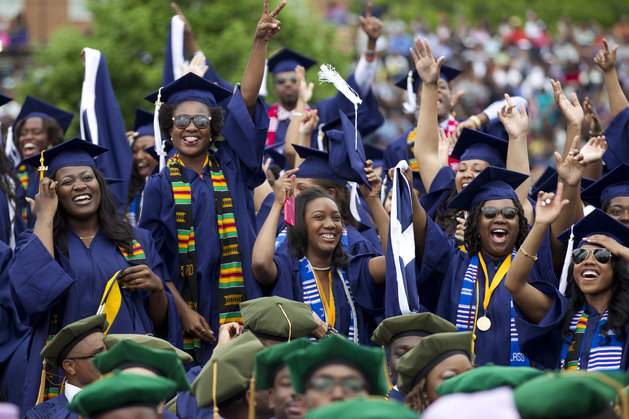(THE HILLTOP) — According to Howard University’s undergraduate admissions, the applicant pool for the class of 2028 increased by 12 percent to about 37,000 applicants, a record, and about 4,000 more than last year’s 33,000 applicants.
Undergraduate admissions officer Andrew Taylor said that the acceptance rate was “about 30 to 32 percent.” Last year’s admission rate was 36 percent, according to Howard’s admission data.
The average GPA of accepted students was in the 3.58 to 3.65 range, according to Taylor, and last year’s incoming freshman class was about 3.65.
The average SAT and ACT scores for accepted students were in the range of 1120 and 1130, and between 23 and 24, respectively. Last year’s average SAT score was a bit higher at 1167, and the average ACT score was about the same.
“Those credentials typically don’t change too much,” he said in the short term, but the admissions team has seen an upward trend in higher marks of accepted applicants.
Students received their Howard admissions decisions on April 12.
Assistant director for undergraduate admissions Karina Sanchez said that there has also been a clear uptrend in the number of applications in the past years, especially since the inauguration of the current Vice President of the U.S. Kamala Harris, who is a class of ‘86 Howard Alumna.
She said the department anticipates rising application counts in the coming years.
The number of students the team decides to accept is heavily based on the capacity of classrooms, the number of professors, and how many classes are offered, according to Sanchez. She confirmed that the overall goal was to enroll more students into Howard, coinciding with the “Enhance Academic Excellence” strategic pillar of the Howard Forward, 2019-2024 plan.

Clarisa Kandakai, an incoming freshman English major and political science minor from Prince George’s County, Maryland, recalled getting her acceptance letter in December as an early decision applicant.
“I was really excited. Howard has been my top choice since my freshman year of high school,” she said. “I was really nervous because out of all of the schools I applied to I thought that would be the one school that wouldn’t accept me.”
Kandakai holds a 3.9 GPA at her high school with many activities on her resume including captaining the varsity cheerleading team, serving as a board member of the school’s modeling organization, and participating in community service.
She visited the campus many times and knew that she wanted to go to an HBCU “for the experience” she said, but did not want to be too far away from home. This led her to look into universities nearby including Hampton University and Bowie State University.
“After visiting and looking into all of the schools, I just felt like Howard was the one. I loved the campus and the organizations,” she said.
Josiah Smith, a prospective incoming freshman broadcast and digital journalism major from Haughton, Louisiana, got his acceptance earlier this month as a regular decision applicant.
Smith was apprehensive about applying to an HBCU at first due to growing up in what he said was a predominantly white area, but he was reassured by friends and family that there would be a diverse group of students with different backgrounds attending Howard with him.

Smith visited Howard last summer and “instantly fell in love with the campus,” he said, remembering how it felt to be there. He said, “the aura and vibe just felt different.”
Smith also holds a 3.9 GPA at his high school, is top 25 in his graduating class, and is an athlete and member of the National Honor Society. He has a strong interest in journalism and felt that Howard being in “the heart of D.C.” opens him up to a plethora of opportunities, where he’d be able to foster connections with people in the industry.
“Howard feels like the perfect place for me,” he said, “If I end up going to Howard, I’m excited to be a Bison…experience Howard Homecoming – Yardfest and really just be surrounded by people who look like me and want me to succeed.”
Sanchez works with undergraduate international students within the admissions department and mentioned that about 7 percent of the Howard population is made up of international students. She said that the majority of international applicants come from West African, South Asian and Caribbean countries.
The top five countries come from Nigeria, Jamaica, Nepal, the Bahamas, and Trinidad and Tobago, she said.
She also mentioned that there are certain aspects of an application that admissions officers don’t necessarily take into much consideration, due to the unique aspect of Howard being an HBCU along with the Supreme Court’s decision to end race-based admissions in the summer of 2023.
“It [affirmative action] doesn’t really affect us too much because we are an HBCU, so the majority of our applicants do come from one demographic,” Sanchez said. “We do get a diverse demographic pool, though, and everyone is weighed equally, so we don’t look at their race or their ethnic background.”
Sanchez did mention that admissions officers for a couple of years have also legally been unable to see an applicant’s race or ethnic background. However, even when they were able to, they continued to look at the applicant from a “holistic approach.”
Sanchez also highlighted the 70 to 30 female-to-male student ratio at Howard, according to the U.S. News, and said that despite the ratio, they are legally unable to admit more of one gender than another because of it.
“We are cognizant about the ratio,” she said, emphasizing that they try their best to foster more male applicants through their “recruitment tactics,” which include visiting all-boys high schools.
Taylor went on to note that having extracurricular activities and strong personal essays are things that the admissions team would like to see more of.
“Getting that insight into who you are outside of your GPA and test score – that is huge,” he said.



